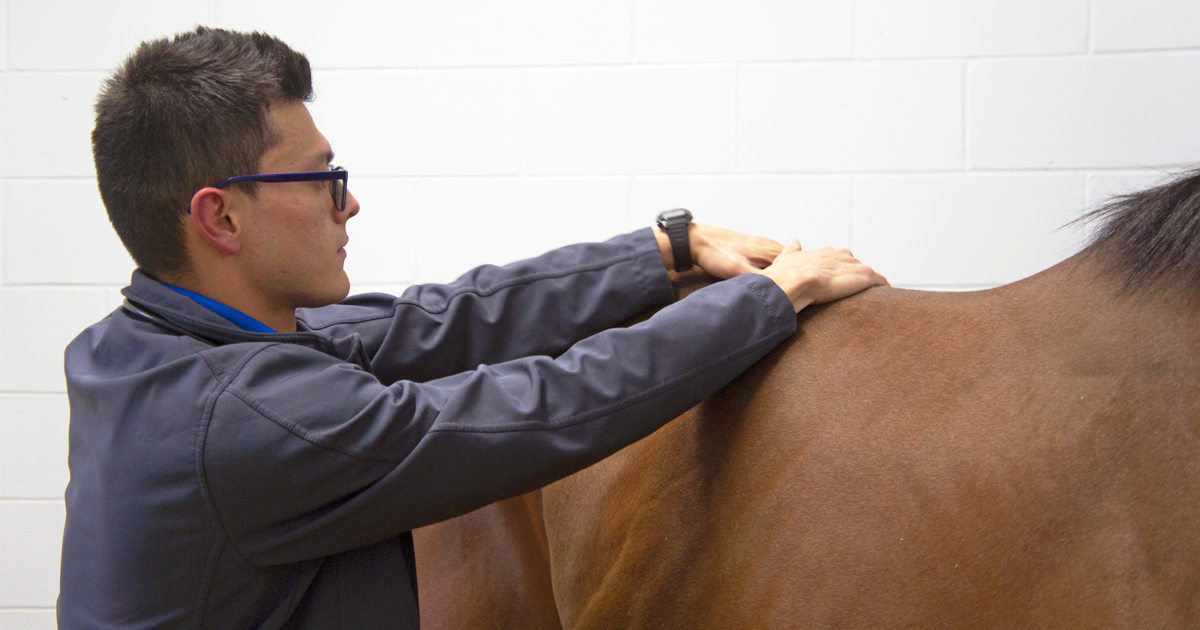Written by Dr. Santiago Rodriguez
2021-2022 Peterson Smith Equine Hospital + Complete Care Hospital Intern
What is it?
Exertional rhabdomyolysis, also called tying up, Monday morning disease or holyday disease, is a debilitating and painful musculoskeletal condition of multifactorial origin, but most caused by strenuous exercise along with dietary imbalances. It affects horses of any breed, age or discipline.
What are the clinical signs?
Tying-up might resemble colic because horses are usually painful (trying to lay down, rolling, muscle fasciculations, excessive sweating, increased heart rate and respiratory rate), but what makes it different is the reluctance to move and the stiff and short-strided gait. Muscles become very tight and sensitive to palpation, mostly over the croup and gluteal areas. In most severe cases, dark, reddish urine can be present. This is due to the excretion of muscle components into the bloodstream which can’t be filtrated by the kidneys and end up coming out through the urine. Horses tend to display signs of anxiety (this is caused by the pain and the inability to move). Clinical signs appear after a sudden increase in work intensity.
What to do if my horse is “tying-up”?
The first thing to do with your horse if it’s showing signs of rhabdomyolysis is rest: HAND-WALKING IS CONTRAINDICATED! Doing otherwise can increase the muscle damage and the stress of the horse. If transportation is needed, the trailer should be brought to the horse.
How can it be treated?
The most useful way to treat this (or any disease) is by diagnosing first! A veterinarian must evaluate the horse in order to establish a proper treatment plan (every patient is different; thus treatments can vary among cases). Usually, this disease is diagnosed based on clinical signs, history and bloodwork. There are two muscle enzymes that will be elevated in the blood sample: Creatine Kinase (CK), and Aspartate Aminotransferase (AST). These enzymes are present within the muscle cells and in the face of cellular damage, they are released into the bloodstream, thus increasing their values in serum. The use of anti-inflammatories such as Bute or Banamine should be consulted with your veterinarian first – this is because NSAIDs tend to be hard on the kidneys and horses with rhabdomyolysis are at risk of developing renal disease. Fluid therapy is the cornerstone of treatment. Most of the time these horses are dehydrated, and replacement of fluid losses is necessary. Sedation can be useful to decrease the anxiety, but its use must also be determined by a veterinarian. Acepromazine is an excellent anxiolytic, but also a great hypotensive; its use is contraindicated in severely dehydrated patients. Xylazine and Dormosedan are excellent choices due to their analgesic and sedative properties.
What to do after an episode of tying up?
Horses with rhabdomyolysis must have a low-calorie diet at least for a couple of weeks following the episode. Electrolyte supplementation is also very important because high amounts of sodium and chloride are wasted during dehydration. This can be achieved by adding 30 to 50gr (1 to 3 tablespoons) of regular salt into the water or feed. Hanging a salt block in the stall is another option. Close monitoring of clinical signs for the first two weeks following the episode is very important because horses are more susceptible to relapse. Exercise should start once the muscular stiffness has been eliminated. First, short hand-walks can be done as long as the horse is willing to do it. Muscle enzymes should also be re-checked every two weeks to monitor the healing process.
What if my horse has recurrence of rhabdomyolysis?
If the horse has recurring tying up episodes, specialized diagnostics should be performed. There might be a chance that your horse has a genetic disorder that makes it prone to tying up! Quarter Horses and Draft horses can be affected by a mutation of the gene GYS1. This mutation leads to an abnormally high accumulation of calcium in the muscle cells. Genetic tests and muscle biopsies should be performed to confirm the diagnosis. The management of these horses is similar to exertional rhabdomyolysis: rest, controlled exercise, and dietary changes. Always consult with your veterinarian on how to adjust these changes based on your horse’s needs!
References
- Reed, S; et al, (2018). Equine Internal Medicine: Exertional Myopathies. Elsevier 4th


